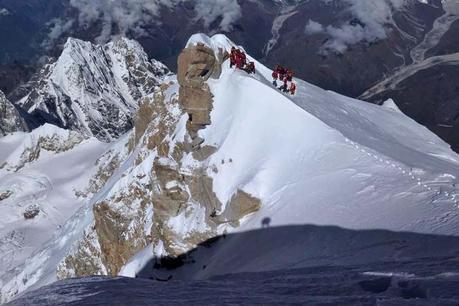 The climbing season on Manaslu may be long over, but the 8163-meter (26,781 ft) mountain continues to garner headlines thanks to this article from The Himalayan times. The story says that of the 150 climbers who summited the mountain this year, only a fraction actually reached the true summit, which is typically defined as the highest point on the mountain. That's because Manaslu's highest point is incredibly dangerous to reach, which calls into question whether or not you actually did get the summit after all.
The climbing season on Manaslu may be long over, but the 8163-meter (26,781 ft) mountain continues to garner headlines thanks to this article from The Himalayan times. The story says that of the 150 climbers who summited the mountain this year, only a fraction actually reached the true summit, which is typically defined as the highest point on the mountain. That's because Manaslu's highest point is incredibly dangerous to reach, which calls into question whether or not you actually did get the summit after all.Those in the know in the mountaineering world understand that there is a narrow ridge that is covered in a snow cornice that runs out to the actual summit of the mountain. That ridge is unstable and difficult to cross, particularly in high winds or other poor weather conditions. As a result, about 90% of the climbers this season turned back approximately 5 to 10 meters below the actual top of the mountain, but still claimed a full summit anyway. This has sparked some debate as to whether or not those claims are actually true.
In writing about a slew of climbing expeditions this fall, Alan Arnette also weighed in on the topic, sharing some of his own experiences. He also reminds us that a Japanese climber perished on Manaslu this year when he fell through the cornice while trying to reach the true summit. That's an indication of just how dangerous the final approach to the top truly is. Although as Alan points out via a quote from Himex boss Russel Brice, the blame is square placed on the team that was put in charge of fixing the ropes to the summit, but failed to complete the final 20 meters, which directly led to this fatality a few weeks back.
When considering where to actually give credit to someone for making the summit on Manaslu, it is important to also note that the incredibly narrow approach to the top serves as a significant bottle-neck for those going up and coming down. It would literally take hours for everyone to shuffle across the approach ridge, even if it were completely safe. That would leave climbers standing in line at the top of the mountain while they waited their turn, leaving them exposed to the elements the entire time. Most of the operators on Manaslu aren't willing to put their clients through that kind of difficulty, so they certify summits at the lower point on the mountain.
On the other hand, getting credit for a summit has always been about reaching the highest point. To take that away from experience doesn't seem completely fair either. Yes, it would mean fewer people climbing Manaslu if they actually had to negotiate that tough final portion of the ascent, but that isn't necessarily a bad thing either. There is a part of me that feels that if you want to actually receive a summit certificate you should have to reach the actual true summit to get credit. Anything else, just comes up short. It is up to the climbers themselves if they actually want to complete those final 20 meters or play it safe and turn back below that point. But if they don't get all the way up, the wouldn't earn full credit either.
Obviously this is a tough call. For safety sake, I understand why they turn back. But for the pure mountaineering aspects of it, they should actually touch the highest point in my opinion.
What do you think? Share your thoughts in the comments section below.

